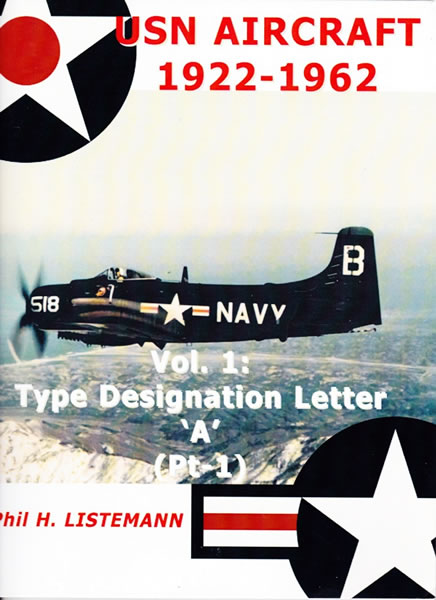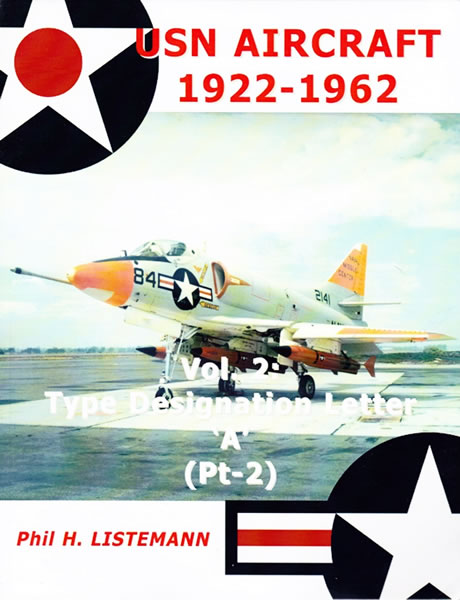USN Aircraft 1922- 1962
Volumes 1 & 2

RAF-In-Combat.com
S u m m a r y |
| Publisher and Title: |
USN Aircraft 1922-1962
Vol.1: Type Designation Letter ‘A’ (Pt.1)
ISBN: 978-1928590-52-1
USN Aircraft 1922-1962
Vol.2: Type Designation Letter ‘A’ (Pt.2)
ISBN: 978-1928590-53-8
by: Phil H. Listermann |
| Media: |
Each features Soft Cover, A4 portrait format, US Trade Paper Binding, 74 pages, or available in PDF, EPUB and SRC digital formats. |
| Price: |
Digital format available on-line from RAF-In-Combat.com for €9.99 and printed copies from Amazon at around US$25.00 for printed, or US$9.99 for digital. |
| Review Type: |
First Read |
| Advantages: |
A good compendium of USN types in service from 1922-1962. |
| Disadvantages: |
|
| Conclusion: |
This series is quite specialized in nature, but with broader appeal and utility than a first glance would suggest. It is certainly useful if you want an illustrated explanation of the USN’s designation system used from 1922-1962, but I think the real value lies in the factual information provided for each designation. Its best use is as a compendium providing development and service summary, description of differences between variants, production data and bureau numbers, plus interesting images.
Maybe not everyone’s idea of a good read I admit, but recommended to those who like to have the above types of reference information close to hand. . |
Reviewed by Mark Davies

HyperScale is proudly supported by Squadron.com
Despite its name, RAF-in-Combat.com publishes titles dealing with air arms other than just the RAF. So far it has 47 titles across six series:
The subjects of this “first read” are the start of quite a major project, perhaps best explained by quoting RAF-In-Combat.com’s introduction to the series:
Over forty years, between 1922 and 1962, the USN and USMC used a designation system which began with biplanes and ended with jets, having been used through two major wars, WW2 and the Korean War. This system remained largely the same during that time, though it evolved with the introduction of new types and technology, and new exceptions developed as well. The purpose of this series is to explain this system using photographs.

At a glance this might seem a most specialised undertaking with a fairly narrow appeal. The decision to explain the designation system using photographs might also be questioned given that the books do so quite effectively using just two pages of text. But such quick and arbitrary assessment really misses what the series has to offer.
The books list in alpha-numeric sequence the aircraft used by the USN during the 40-year period 1922-1962. For each sub-variant there is a précis of its development and service history, a summary of the number of aircraft ordered and accepted, delivery dates and last stricken date. Also very useful is mention of each variant’s distinguishing features from its predecessor and a list of applicable bureaux numbers. Each entry is accompanied usually by at least one, or in most cases, several good photo images of the type being dealt with. These are in both black & white and colour and often include captions covering interesting aspects of the individual aircraft’s service history.
Volume 1 deals almost exclusively with the Douglas Skyraider, although the AE-1 Piper Cub has four pages ahead of the Skyraider as the “A” designated Ambulance from 1943-46).
Volume 2 covers the Douglas Skyshark, Skywarrior and Skyhawk, as well as the Grumman Guardian and Intruder (the latter originally designated A2F-1). It finishes with a brief entry covering the McDonnell YAH-1, of which two test aircraft were ordered but none accepted (although the design would develop into the YF4H-1, better known under its post-1962 designation of F-4 as the Phantom II).
Volume 3: Type Designation Letter ‘A’ (Pt.3) & ‘B’ has also been released, but is not part of this review.
The books are available in four formats, printed paperback through Amazon for around US$25.00 new, or in downloadable in three digital formats PDF, EPUB or PRC (for Kindle) for €9.95. The printed example’s quality of production is good, although on matt paper. I cannot comment on the appearance of the digital formats.
This series is quite specialized in nature, but with broader appeal and utility than a first glance would suggest. It is certainly useful if you want an illustrated explanation of the USN’s designation system used from 1922-1962, but I think the real value lies in the factual information provided for each designation. Its best use is as a compendium providing development and service summary, description of differences between variants, production data and bureau numbers, plus interesting images.
Not everyone’s idea of a good read I admit, but recommended to those who like to have the above types of reference information close to hand.

Review Copyright © 2015 by Mark Davies
This Page Created on 10 June, 2015
Last updated
10 June, 2015
Back to HyperScale Main Page
Back to Reviews Page
|
